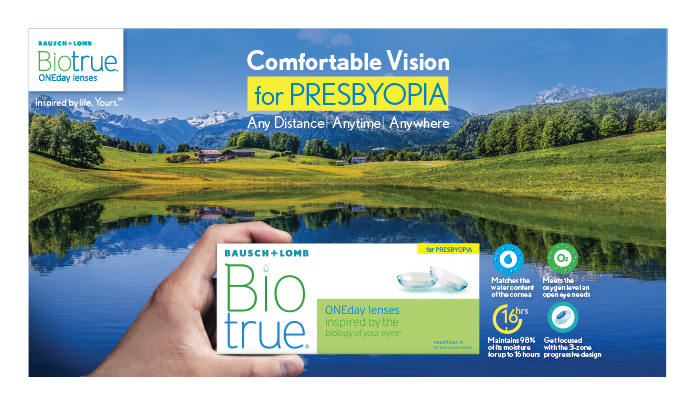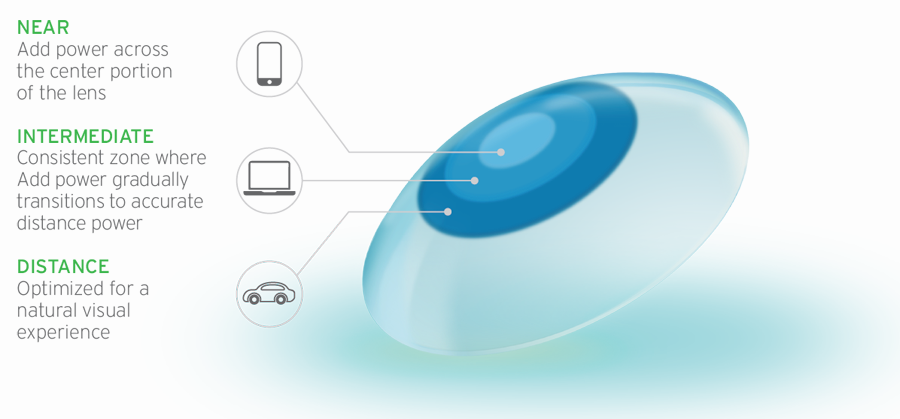
If you find yourself holding books, menus and phone screens farther and farther away in order to focus properly, or if close work, like reading or handwriting, gives you headaches or eyestrain, you may be showing early signs of presbyopia.
Biotrue ONEday for Presbyopia daily disposable multifocal lens has a 3-Zone Progressive Design to help you see clearly and comfortably with your contacts, up close, far away, and in between. Biotrue ONEday for Presbyopia is made of a unique material that works like the eye to form a dehydration barrier providing comfort all day long.
Bausch + Lomb 3-Zone Progressive Design
You are constantly changing where you are looking, whether reading, working on a computer, or driving, it is important that your multifocal lenses keep up. Biotrue ONEday for Presbyopia features 3-Zone Progressive Design for clear vision up close, far away, and in between.

Key Features & Benefits
- Mimics the lipid layer of the tear film.
- Matches the water content of the cornea.1
- Allows for the oxygen a healthy eye needs.2
- Maintains 98% of its moisture for up to 16 hours.3
- 3-Zone Progressive Design gives you clear vision up close, far away, and in between.4
- UVA/UVB protection to help protect your eyes along with sunglasses.†
Ask your eye care professional about Biotrue ONEday for Presbyopia contact lenses today.
Is this product right for you? |
†WARNING: UV-absorbing contact lenses are NOT substitutes for protective UV-absorbing eyewear, such as UV-absorbing goggles or sunglasses, because they do not completely cover the eye and surrounding area. The effectiveness of wearing UV-absorbing contact lenses in preventing or reducing the incidence of ocular disorders associated with exposure to UV light has not been established at this time. You should continue to use UV-absorbing eyewear as directed. NOTE: Long-term exposure to UV radiation is one of the risk factors associated with cataracts. Exposure is based on a number of factors such as environmental conditions (altitude, geography, cloud cover) and personal factors (extent and nature of outdoor activities). UV-blocking contact lenses help provide protection against harmful UV radiation. However, clinical studies have not been done to demonstrate that wearing UV-blocking contact lenses reduces the risk of developing cataracts or other eye disorders.
*An eye exam may be necessary before receiving your free trial, and the free trial certificate does not include the cost of an eye examination or any other professional fees.
REFERENCES:
1. Bergmanson J. Clinical Ocular Anatomy and Physiology, 14th edition, 2007
2. Brennan N. Beyond Flux: Total Corneal Oxygen Consumption as an Index of Corneal Oxygenation During Contact Lens Wear. Optometry and Vision Science. Vol. 82, No. 6, June 2005.
3. Twenty-two subjects participated in a randomized, double-masked, contralateral eye study to evaluate water loss of Biotrue ONEday, 1-Day Acuvue Moist, and 1-Day Acuvue TruEye contact lenses. After 4, 8, 12, and 16 hours of wear, lenses were removed and immediately weighed (wet weight). The lenses were then completely dried and reweighed (dry wet). The percent water loss was then calculated for each lens from the wet and dry weights.
4. Data on file. Bausch & Lomb Incorporated. Rochester, NY; 2015.